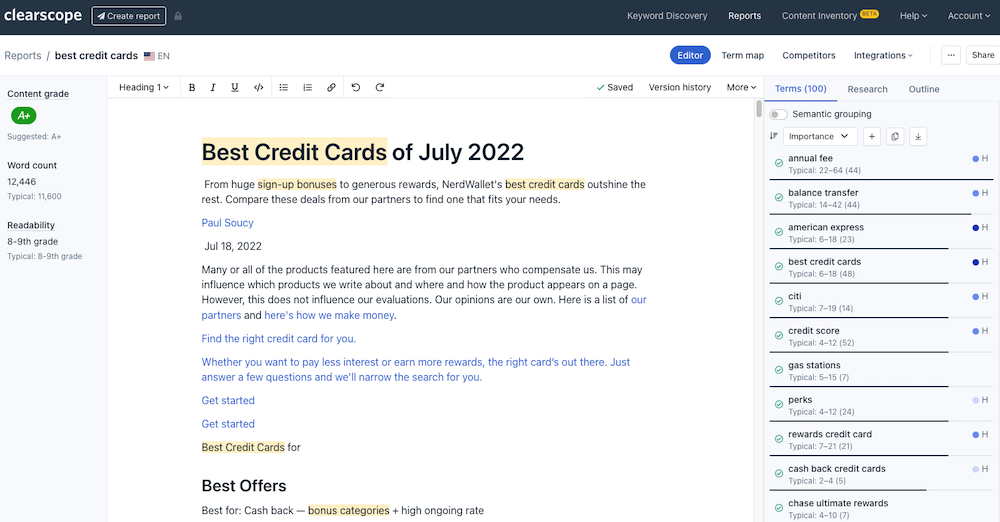Where does Clearscope fit into all this?
“The original goal was not to do consulting, but to start our own thing,” Bernard told me.
So as with GameRunners, Bernard and Kevin set out to develop a product—this time, focusing on the SEO space.
After spending a lot of time poring over spreadsheets and using data from the machine learning company AlchemyAPI for clients, they sought to automate their manual processes. Bernard saw potential in natural language processing, a branch of AI aimed at using computers to understand information from text and speech.
“I thought it would be interesting if we tested using natural language processing to optimize content copy to see whether or not it has an impact on organic rankings,” Bernard explained.
Product development
Having graduated from college with an economics degree, Bernard considers himself the “non-technical founder.” When I asked about the technical work behind Clearscope’s product development, he gave his co-founder, Kevin Su, all of the credit.
According to Bernard, “Kevin has been the full-stack product brilliance behind the tool from day one. … The brilliance and simplicity of Clearscope can only be attributed to Kevin's ability to have a strong product sense.”
But before Kevin could create Clearscope’s software, the two needed to validate its proof of concept. They didn’t want another flop like GameRunners. So following the principles of lean customer methodology, the two decided to “sell it before you build it.”
Kevin created an HTML/CSS mockup of their software idea, and taking screenshots of it, Bernard made a slide deck about the product. Then he worked on connecting with other SEO professionals in San Francisco through cold email outreach. Here’s a look at one of his emails:
Bernard used cold outreach to connect with other SEOs in San Francisco. Note that he asked for the prospect’s input—he didn’t try selling anything outright.
A few details worth highlighting:
- Bernard’s email wasn’t overly personalized, yet it still came across as a tailored message. It’s clear he did his homework on the prospect—he knew they were a “fellow SEO in SF” and included the name of the prospect’s company.
- Although Bernard wanted to pitch his product idea to gauge potential interest, his email ask wasn’t blatantly about selling. Instead, he shared honestly that he was “exploring potential products to help people manage internal SEO stuff.”
- What’s more, Bernard’s ask revolved around meeting to get the prospect’s advice and input. It was clearly a two-way conversation (“trade SEO war stories”), not a one-sided sales pitch.
Bernard set up coffee meetings with around 40-50 SEOs. In each one, he walked the prospect through the slide deck with screenshots of Kevin’s software mockup, explaining what the hypothetical product would do.
“At the end, there used to be a slide that said, ‘We'll do this all for $500 a month’—to price test it,” he recalled. “Then I'd ask, ‘If we built this, would this be something that you'd be interested in purchasing?’”
Bernard estimated that 20-30% of these prospects said they’d buy it or at least check it out—enough for him to tell Kevin, “I think we have enough to start working on it.”
From there, the two paused on taking new clients for Mushi Labs so they could create Clearscope’s software.
Reflecting on this, Bernard chuckled. “Our mindset was ‘There's no Plan B, we just got to make this work.’ We kind of burned the boats, and went all in on Clearscope.”
Early traction (customers 1-10)
You might expect that Clearscope naturally grew by funneling clients from Mushi Labs. It’s totally plausible: Wanting to productize their work, two experts running an SEO consulting service develop software that they then market to their existing clients.
Not quite.
Bernard shared that he and his co-founder actually converted very few of their consulting clients into Clearscope customers.
“When people go with a consultant, they’re going with a consultant because they want you to do the work,” he said. “When you sell them software, they have to do the work.”
Bernard’s point is a good reminder of the importance of understanding your target audience and what “job” they “hire” your product for, according to the jobs-to-be-done framework. If you're changing your business model or trying a new product, don’t assume your existing audience will be interested.
So how did Bernard find Clearscope’s earliest clients? Once again, he turned to outreach—this time, within his network.
Professional relationship management
Early on, Bernard made it a habit to export all of his LinkedIn contacts into a spreadsheet at the end of the year—a virtual Rolodex of sorts. He assessed each contact based on their value as a potential Clearscope client.
Then he carefully developed a few email templates with which to reach out:
- a standard outreach email
- a semi-personalized version
- a heavily customized one
Above is one of Bernard’s year-end outreach templates. This is the standard version—but as you can see, it still reads as warm and personable.
Unlike the cold emails he used during the product development stage, Bernard didn’t have a concrete ask. His messages functioned more as a friendly update and conversation starter, and they placed his name top of mind—perfect in case any of his contacts had SEO needs.
“The whole intention was really to just tell people what I was doing—to get that conversation going in case it popped up in people's day-to-day,” Bernard said.
This wasn’t quite cold outreach, since Bernard knew these contacts. Taking inspiration from Keith Ferrazzi and Tahl Raz’s book about networking, Never Eat Alone, he instead called the strategy “professional relationship management.”
And it worked, gradually pulling in Clearscope’s earliest customers.
“If you can't sell your friends on professional services that you're offering, you're not going to be able to sell a random stranger on it,” Bernard said. “Your first five customers are probably going to come from your network if you're selling consulting or agency type of services.”
With this philosophy in mind, Bernard avoided using paid ads. People who knew Bernard and his track record of SEO success felt confident in signing up for Clearscope, a product that had no reviews or case studies at the time.
Ensuring product adoption
There was no time to sit back and relax after Clearscope signed on its first handful of customers. Since its software was so new, Bernard and Kevin knew it needed refining.
“It was still lacking a lot of things,” Bernard recalls. “What we wanted to optimize for early on was learning—learning what to say, who to say it to, what clients wanted, what they resonated with, what they wanted to see—all of that good stuff.”
To find out how to improve the product, the two looked to their early customers. Kevin wrote a webhook for Slack that would automatically send a message whenever a client ran a report in Clearscope. Seeing these messages appear made Bernard and Kevin happy—but also revealed which clients weren’t actually using Clearscope.
Bernard reached out to these inactive customers to check in on them. His logic: Customers wouldn’t value Clearscope if they didn’t use it. So he worked on finding out what customers wanted and guiding them to product adoption as much as possible, even if that involved taking a very active role in their product implementation.
Bernard persistently reached out to customers who weren’t using Clearscope’s software. He could identify them based on a webhook his co-founder wrote.
Bernard recalled giving a generous discount to convert one trial user into a Clearscope customer—only to find that after signing up, the customer barely used the software. So he offered to optimize 10 articles for them, asking only that he be able to use the resulting data for a case study.
Bernard offered an inactive Clearscope user free optimization work at the end of one of his emails.
The customer happily agreed. Ten articles later, data from Google Search Console showed that optimization with Clearscope led to a 52% average increase in the customer’s search traffic. Some pages got as much as a 230% boost.
“This was one of the biggest breakthroughs in customers one through 10,” Bernard noted.
And it wasn’t just the one client who saw results—Bernard extended his offer to other early customers to create more case studies. The data helped justify Clearscope’s cost against lower-priced SEO software like Ahrefs, and would set the stage for further growth.













